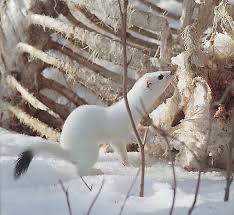
What keeps astounding me is how many critters live among us that I’m obliviously unaware of. This week one evening, I was hunkered down in my office that looks onto the patio beneath the deck. A flash of white outside caught my eye, but after not seeing anything, I resumed my writing. Then it happened again—a white streak crossing the window at eye level. What the heck? It’s not like Grand Lake has laboratories that a white mouse could have escaped from to save itself from cosmetic testing. Then I made a point of watching. Unbelievably, I soon saw a creature jump onto the table and then dive into the three foot pile of kindling I’d collected for our winter fires. It was pure white and the very tip of its short tail was black. It seriously took my husband quite a while scouring the Internet to figure out that I just encountered my first ermine.
This little scrapper actually has three correct names. “Ermine” is used when it’s fur is pure white, which happens in the winter, and it’s called a “stoat” when it has reddish-brown fur on its back and white fur on its belly, which is it’s summer coat. It’s also called a short-tailed weasel. Ermine can be found in North America, Europe and Asia in the subarctic and arctic climates (when winter is just rolling in, it’s kind of daunting to face the fact that subarctic mammals thrive here). Due to the ermine’s warm coat, it doesn’t need to hibernate, which is also what made its fur a prized material for the royals’ collars and coat linings in Medieval Europe. Despite that, the number of ermine in the wild is still large and stable.
And, like it’s adorable cousin the otter, it’s a ferocious carnivore. It will feed on pretty much anything it can catch—including the voles that scamper under the snow and continue destroying our lawns all winter (gorge to your heart’s content, Whitey!). Their sleek, flexible bodies allow them to easily enter their preys’ dens and burrows. The ermine will kill the inhabitant by inflicting a bite to the back of the neck, suffocating it by crushing the connection between the brain and body. After filling its white belly, it will save the excess meat for later. Then, instead of returning to its own home, the ermine will take over the now-vacant burrow . . . and then decorate the chamber’s walls and floor with the dead animal’s skin and fur. Yes, they’re seriously the Buffalo Bill (think “Silence of the Lambs”) of the Rocky Mountains.
But this wily badass doesn’t only go after small mammals. I watched a heart-warming YouTube video of a stoat (it was summer) chasing down and killing a rabbit ten times its size. And, when it can’t manage to catch the rabbit, it resorts to hypnotizing it with a “dance” until it can deliver the killing bite. So, here’s my question: do I really want to fight off the ermine for kindling all winter, or do I just resign myself to buying firestarter?
Originally published in The Boardwalk newspaper, Grand Lake, Colorado.
